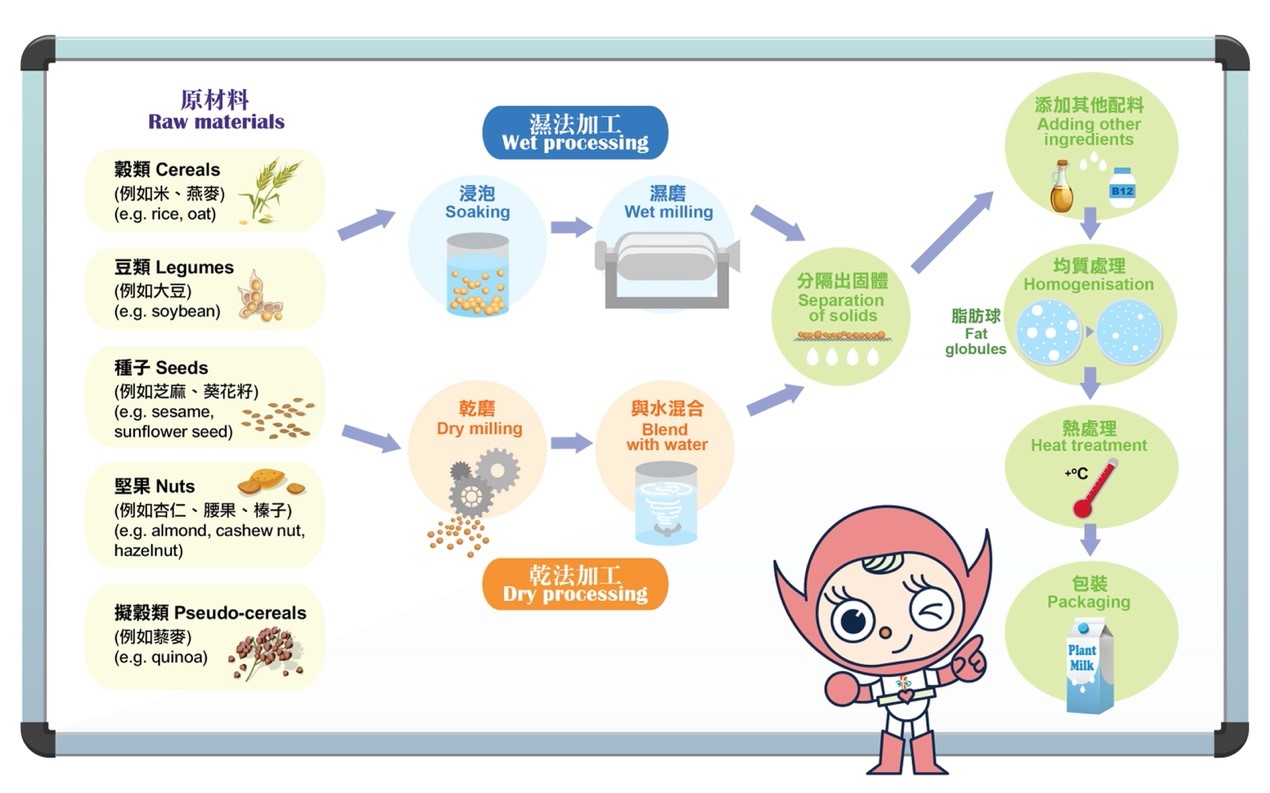
Food Safety Focus (190th Issue, May 2022) – Article 1
More about Plant-based Milk Alternatives
Reported by Mr. Arthur YAU, Scientific Officer,
Risk Communication Section, Centre for Food Safety
While cow's milk is commonly consumed worldwide, some consumers want to reduce their consumption of animal products, including dairy products out of considerations such as their own consideration for health, environment and ethics. To fulfil the demand, the food industry is producing a variety of plant-based milk alternatives (PBMAs) as an alternative for cow's milk that are often available at supermarkets, cafes and some restaurants. This article will discuss the food safety issues of PBMAs.
Production of Plant-based Milk Alternatives
The concept of PBMAs is not new. Soya milk has a long history in China, dating back to the Han dynasty, whereas almond milk was first reported in the Middle East in the thirteenth century. On the other hand, the demand for PBMAs has grown significantly in recent decades due to the increased awareness of lactose intolerance and other considerations, and the increasing acceptance by western consumers as an alternative to cow's milk due to improvements in taste, price and availability.
There is a large variety of PBMAs available these days, including those made from legumes (e.g. soybean), cereals (e.g. rice, oat), nuts (e.g. almond) and other seeds. PBMAs can generally be processed in two ways: wet or dry (Figure 1). In wet milling, the main raw materials are soaked in water before they are milled. Enzymes are sometimes added to break down certain components like carbohydrates and proteins. In dry processing, the raw materials are first milled into powder, followed by treatments to isolate the desired ingredients before soaking with water. The liquid extracts from both processes are then homogenised to reduce the size of fat globules, making the fat less likely to separate and the product more consistent. It will then be heat treated to reduce the possibility of spoilage. Because of the differences in protein and fat content, PBMAs have taste and mouthfeel distinct from dairy products.

Figure 1. The production of PBMAs
Food Safety, Nutritional and Allergy Concerns
PBMAs, like cow's milk, are rich in nutrients which can facilitate the growth of bacteria, impairing the quality and safety during storage. Heat treatments can prolong the shelf life of PBMAs and also impart desirable taste. As with milk, pasteurised PBMAs must be refrigerated, whereas sterilised products can be stored at ambient temperature. Consumers should be aware that the durability and storage method of a PBMA product will be affaected once the package is opened – consume or refrigerate as soon as possible after opening and always follow the manufacturer's storage instructions.
PBMAs are quite variable in their composition compared to cow's milk. Unfortified soya milk, for example, has one-tenth the calcium content of milk. Therefore, if using PBMAs as a substitute for milk and a primary source of dietary calcium, one should read the calcium amounts on the nutrition labels of PBMA products. Furthermore, the levels of free sugars and fats in PBMAs vary, depending on the natural and added levels. Free sugars, such as those from cane juice and maple syrup, as well as fats and oils are often added to PBMAs for better taste and mouthfeel. For persons who adopt a strict vegetarian diet, PBMAs or cereals fortified with vitamin B12 should be used as a milk replacement, as no plant has been demonstrated to be a safe and dependable source of vitamin B12. Finally, since the quality of protein from plant sources is generally regarded as less optimal than that of meat and milk, vegetarians are advised to consume a variety of nuts, seeds, legumes and soy products in order to achieve balanced nutrition. Of note, children need sufficient protein and energy for normal growth and development. If PBMAs are a regular part of a growing child's diet, other food sources of protein and energy need to replace the protein and energy otherwise provided by milk.
Some people may choose PBMAs due to lactose intolerance or allergy to cow's milk protein. Notably, a number of PBMAs may contain allergens like soybeans, cereals and nuts that are not present in milk and can cause significant reactions in susceptible populations. Upon purchase, consumers should read the food allergen information on food labels to avoid undesirable ingredients.
Advice to the Trade
- Food manufacturers should ensure that the labelling for PBMA products is accurate and fulfils the local regulatory requirement on the labelling of food nutrition and allergens.
- The trade should store PBMA products properly as instructed. Catering outlets should refrigerate opened PBMAs and use them as soon as possible.
Advice to Consumers
- Follow the instructions for storing PBMA products and consume them as soon as possible once opened.
- Note that PBMAs are not suitable for anyone allergic to the substance(s) from which the beverages are derived. Always read the ingredient list and food allergen information on food labels.
- Read nutrition labels to compare the nutritional content among different dairy/PBMA products for suiting one's needs (e.g. source of calcium) and a healthier choice (e.g. lower intake of sugar and fat).
- Seek professional advice if you are considering to replace milk in your children's diet with PBMAs.

